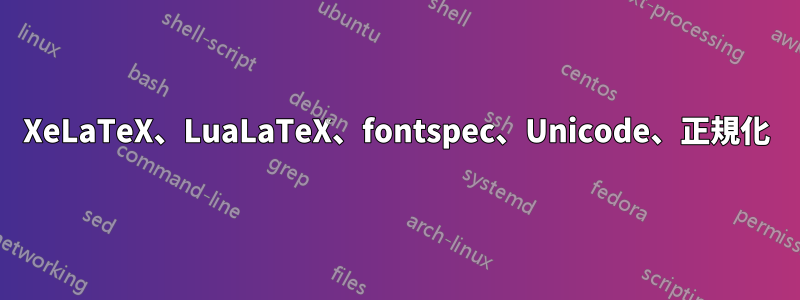
LuaTeX と XeLaTeX が Unicode 合成文字を正規化する方法に困っています。つまり、NFC / NFD です。
次のMWEを参照してください
\documentclass{article}
\usepackage{fontspec}
\setmainfont{Linux Libertine O}
\begin{document}
ᾳ GREEK SMALL LETTER ALPHA (U+03B1) + COMBINING GREEK YPOGEGRAMMENI (U+0345)
ᾳ GREEK SMALL LETTER ALPHA WITH YPOGEGRAMMENI (U+1FB3)
\end{document}
LuaLaTeX を使用すると次のようになります:

ご覧のとおり、LuaはUnicode文字を正規化しません。また、Linux Libertineにはバグがあります(http://sourceforge.net/p/linuxlibertine/bugs/266/)、私は性格が悪いです。
XeLaTeXを使用すると、
ご覧のとおり、Unicode は正規化されています。
私の質問は3つあります:
- なぜXeLaTeXは(NFCで)標準化されたのか、私は使っていないのに
\XeTeXinputnormalization - この機能は以前から変更されましたか?私の以前のTeXLive 2012では悪い結果になりました(この時点で書いた記事を参照してください)http://geekographie.maieul.net/Normalisation-des-caracteres)
\XeTeXinputnormalizationLuaTeXには XeTeXのようなオプションがありますか?
答え1
私は XeTeX を使用していないため、最初の 2 つの質問の答えはわかりませんが、3 番目の質問に対するオプションを提供したいと思います。
感謝アーサーのコードLuaLaTeXでUnicode正規化の基本パッケージを作成することができました。現在のLuaTeXで動作させるには、コードを少し変更するだけで済みました。ここではメインのLuaファイルのみを掲載しますが、完全なプロジェクトは以下で入手できます。Github を非正規化として。
使用例:
\documentclass{article}
\usepackage{fontspec}
\usepackage[czech]{babel}
\setmainfont{Linux Libertine O}
\usepackage[nodes,buffer=false, debug]{uninormalize}
\begin{document}
Some tests:
\begin{itemize}
\item combined letter ᾳ %GREEK SMALL LETTER ALPHA (U+03B1) + COMBINING GREEK YPOGEGRAMMENI (U+0345)
\item normal letter ᾳ% GREEK SMALL LETTER ALPHA WITH YPOGEGRAMMENI (U+1FB3)
\end{itemize}
Some more combined and normal letters:
óóōōöö
Linux Libertine does support some combined chars: \parbox{4em}{příliš}
\end{document}
(このファイルの正しいバージョンは Github にありますが、この例では結合された文字が誤って転送されています)
パッケージの主なアイデアは次のとおりです。入力を処理し、文字の後に複合マークが続く場合は、それを正規化された NFC 形式で置き換えます。2 つの方法が提供されており、最初のアプローチは、ノード処理コールバックを使用して、分解されたグリフを正規化された文字に置き換えることでした。これには、ノード属性を使用して、どこでも処理のオン/オフを切り替えることができるという利点があります。もう 1 つの可能な機能は、現在のフォントに正規化された文字が含まれているかどうかを確認し、含まれていない場合は元の形式を使用することです。残念ながら、私のテストでは、一部の文字で失敗しました。特に、composed はではなくíとしてノードに含まれており、正規化後に正しい文字が生成されないため、代わりに合成文字が使用されます。しかし、これにより、アクセントの位置が不適切な出力が生成されます。したがって、この方法は何らかの修正が必要であるか、完全に間違っています。dotless i + ´i + ´
したがって、もう 1 つの方法は、コールバックを使用して、process_input_bufferディスクから読み取られる入力ファイルを正規化することです。この方法では、フォントの情報を使用することも、行の途中でオフにすることもできませんが、実装が非常に簡単です。コールバック関数は次のようになります。
function buffer_callback(line)
return NFC(line)
end
これは、ノード処理バージョンに 3 日間費やした後の本当に素晴らしい発見です。
興味深いことに、これは Lua パッケージです:
local M = {}
dofile("unicode-names.lua")
dofile('unicode-normalization.lua')
local NFC = unicode.conformance.toNFC
local char = unicode.utf8.char
local gmatch = unicode.utf8.gmatch
local name = unicode.conformance.name
local byte = unicode.utf8.byte
local unidata = characters.data
local length = unicode.utf8.len
M.debug = false
-- for some reason variable number of arguments doesn't work
local function debug_msg(a,b,c,d,e,f,g,h,i)
if M.debug then
local t = {a,b,c,d,e,f,g,h,i}
print("[uninormalize]", unpack(t))
end
end
local function make_hash (t)
local y = {}
for _,v in ipairs(t) do
y[v] = true
end
return y
end
local letter_categories = make_hash {"lu","ll","lt","lo","lm"}
local mark_categories = make_hash {"mn","mc","me"}
local function printchars(s)
local t = {}
for x in gmatch(s,".") do
t[#t+1] = name(byte(x))
end
debug_msg("characters",table.concat(t,":"))
end
local categories = {}
local function get_category(charcode)
local charcode = charcode or ""
if categories[charcode] then
return categories[charcode]
else
local unidatacode = unidata[charcode] or {}
local category = unidatacode.category
categories[charcode] = category
return category
end
end
-- get glyph char and category
local function glyph_info(n)
local char = n.char
return char, get_category(char)
end
local function get_mark(n)
if n.id == 37 then
local character, cat = glyph_info(n)
if mark_categories[cat] then
return char(character)
end
end
return false
end
local function make_glyphs(head, nextn,s, lang, font, subtype)
local g = function(a)
local new_n = node.new(37, subtype)
new_n.lang = lang
new_n.font = font
new_n.char = byte(a)
return new_n
end
if length(s) == 1 then
return node.insert_before(head, nextn,g(s))
else
local t = {}
local first = true
for x in gmatch(s,".") do
debug_msg("multi letter",x)
head, newn = node.insert_before(head, nextn, g(x))
end
return head
end
end
local function normalize_marks(head, n)
local lang, font, subtype = n.lang, n.font, n.subtype
local text = {}
text[#text+1] = char(n.char)
local head, nextn = node.remove(head, n)
--local nextn = n.next
local info = get_mark(nextn)
while(info) do
text[#text+1] = info
head, nextn = node.remove(head,nextn)
info = get_mark(nextn)
end
local s = NFC(table.concat(text))
debug_msg("We've got mark: " .. s)
local new_n = node.new(37, subtype)
new_n.lang = lang
new_n.font = font
new_n.char = byte(s)
--head, new_n = node.insert_before(head, nextn, new_n)
-- head, new_n = node.insert_before(head, nextn, make_glyphs(s, lang, font, subtype))
head, new_n = make_glyphs(head, nextn, s, lang, font, subtype)
local t = {}
for x in node.traverse_id(37,head) do
t[#t+1] = char(x.char)
end
debug_msg("Variables ", table.concat(t,":"), table.concat(text,";"), char(byte(s)),length(s))
return head, nextn
end
local function normalize_glyphs(head, n)
--local charcode = n.char
--local category = get_category(charcode)
local charcode, category = glyph_info(n)
if letter_categories[category] then
local nextn = n.next
if nextn.id == 37 then
--local nextchar = nextn.char
--local nextcat = get_category(nextchar)
local nextchar, nextcat = glyph_info(nextn)
if mark_categories[nextcat] then
return normalize_marks(head,n)
end
end
end
return head, n.next
end
function M.nodes(head)
local t = {}
local text = false
local n = head
-- for n in node.traverse(head) do
while n do
if n.id == 37 then
local charcode = n.char
debug_msg("unicode name",name(charcode))
debug_msg("character category",get_category(charcode))
t[#t+1]= char(charcode)
text = true
head, n = normalize_glyphs(head, n)
else
if text then
local s = table.concat(t)
debug_msg("text chunk",s)
--printchars(NFC(s))
debug_msg("----------")
end
text = false
t = {}
n = n.next
end
end
return head
end
--[[
-- These functions aren't needed when processing buffer. We can call NFC on the whole input line
local unibytes = {}
local function get_charcategory(s)
local s = s or ""
local b = unibytes[s] or byte(s) or 0
unibytes[s] = b
return get_category(b)
end
local function normalize_charmarks(t,i)
local c = {t[i]}
local i = i + 1
local s = get_charcategory(t[i])
while mark_categories[s] do
c[#c+1] = t[i]
i = i + 1
s = get_charcategory(t[i])
end
return NFC(table.concat(c)), i
end
local function normalize_char(t,i)
local ch = t[i]
local c = get_charcategory(ch)
if letter_categories[c] then
local nextc = get_charcategory(t[i+1])
if mark_categories[nextc] then
return normalize_charmarks(t,i)
end
end
return ch, i+1
end
-- ]]
function M.buffer(line)
--[[
local t = {}
local new_t = {}
-- we need to make table witl all uni chars on the line
for x in gmatch(line,".") do
t[#t+1] = x
end
local i = 1
-- normalize next char
local c, i = normalize_char(t, i)
new_t[#new_t+1] = c
while t[i] do
c, i = normalize_char(t,i)
-- local c = t[i]
-- i = i + 1
new_t[#new_t+1] = c
end
return table.concat(new_t)
--]]
return NFC(line)
end
return M
さて、写真を撮る時間です。
正規化なし:

ギリシャ文字の組み合わせが間違っていることがわかります。他の組み合わせはLinux Libertineでサポートされています。
ノード正規化の場合:

ギリシャ文字は正しいですが、íin firstpřílišが間違っています。これが私が話していた問題です。
次にバッファの正規化を行います。

すべては大丈夫です


